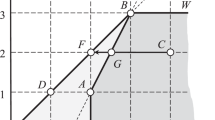Abstract
We provide a unifying framework synthesizing the dual spaces of production and value used in DEA efficiency measurement with some well-known linear programming (LP) problems. Specifically, we make use of the technology matrix to map intensity variables into input–output space, and the adjoint transformation of the technology matrix to map input–output prices into prices of intensity variables. We show how the diet problem, a classical LP problem, is related to DEA and also use the adjoint matrix to demonstrate a procedure for pricing efficient decision-making units. We further illustrate the relationship between benefit-of-the-doubt aggregation and the diet problem.




Similar content being viewed by others
Notes
Charnes et al. (1978).
This is one of our interpretations of Magill and Quinzii (1996), Figure 13.1.
In the profit maximization problem we may want to restrict the intensity variables to satisfy \(\sum _{k=1}^Kz_k\leqq 1\) or \(=1\) in order for the maximum to exist.
Originally developed by Färe et al. (2013).
Färe et al. (2011) have shown by means of formulating a Langrangian–Kuhn–Tucker problem that the diet problem can be considered to be dual to the DEA profit maximization problem in the sense that the intensity variables in the profit maximization model are shadow prices in the diet problem.
The importance of the BoD model in constructing composite performance indicators is emphasized by the OECD (2008).
References
Charnes, A., Cooper, W. W., & Rhodes, E. (1978). Measuring the efficiency of decision making units. European Journal of Operational Research, 2, 429–444.
Cherchye, L., Moesen, W., Rogge, N., & van Puyenbroeck, T. (2007). An introduction to “benefit of the doubt” composite indicators. Social Indicators Research, 82, 111–145.
Dorfman, R., Samuelson, P. A., & Solow, R. M. (1958). Linear programing and economic analysis. New York: McGraw-Hill.
Färe, R., & Grosskopf, S. (2002). Two perspectives on DEA: Unveiling the link between CCR and Shephard. Journal of Productivity Analysis, 17, 41–47.
Färe, R., & Karagiannis, G. (2014). Benefit-of-the-doubt aggregation and the diet problem. Omega, 47, 33–35.
Färe, R., & Zelenyuk, V. (2015). Pricing of decision making units under non-constant returns to scale. Journal of Operational Research Society, 66, 172–173.
Färe, R., Grosskopf, S., & Margaritis, D. (2013). Pricing decision-making units. Journal of Operational Research Society, 64, 612–619.
Färe, R., Grosskopf, S., & Margaritis, D. (2011). The diet problem and DEA. Journal of Operational Research Society, 62, 1420–1422.
Farrell, M. J. (1957). The measurement of productive efficiency. Journal of Royal Statistical Society Series A, 120, 253–290.
Lovell, C. A. K., & Pastor, J. T. (1999). Radial DEA models without inputs or without outputs. European Journal of Operational Research, 118, 46–51.
Liu, W. B., Zhang, D. Q., Meng, W., Li, X. X., & Xu, F. A. (2011). A study of DEA models without explicit inputs. Omega, 39, 472–480.
Magill, M., & Quinzii, M. (1996). Theory of incomplete markets. Cambridge, MA: MIT Press.
OECD. (2008). Handbook on constructing composite indicators: Methodology and user guide. Paris: OECD.
Shephard, R. W. (1953). Cost and production functions. Princeton: Princeton University Press.
Shephard, R. W. (1970). Theory of cost and production functions. Princeton: Princeton University Press.
Stigler, G. J. (1945). The cost of subsistence. Journal of Farm Economics, 27, 303–314.
Author information
Authors and Affiliations
Corresponding author
Additional information
We thank two anonymous referees for their comments.
Rights and permissions
About this article
Cite this article
Färe, R., Grosskopf, S., Karagiannis, G. et al. Data envelopment analysis and its related linear programming models. Ann Oper Res 250, 37–43 (2017). https://doi.org/10.1007/s10479-015-2042-y
Published:
Issue Date:
DOI: https://doi.org/10.1007/s10479-015-2042-y




